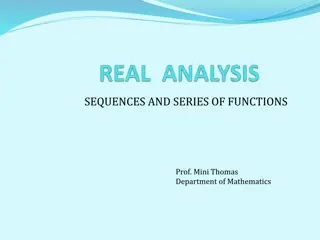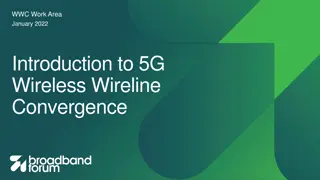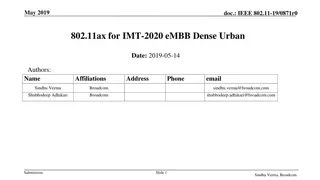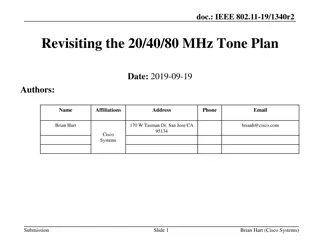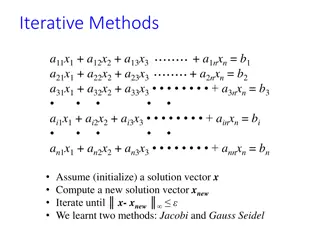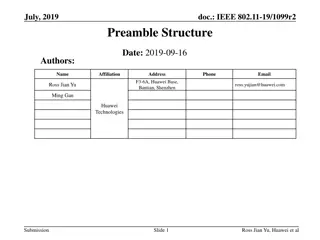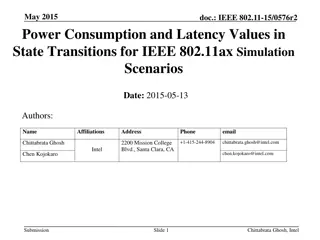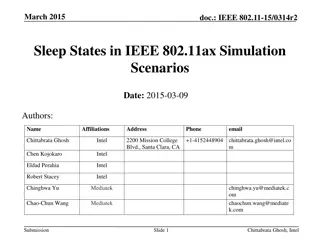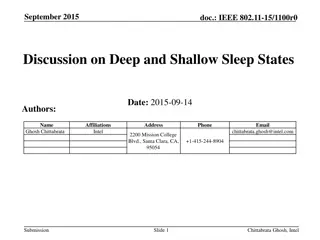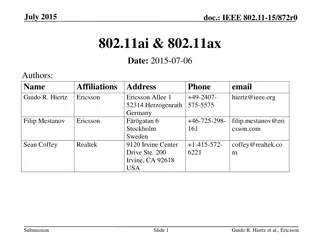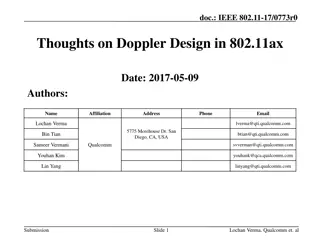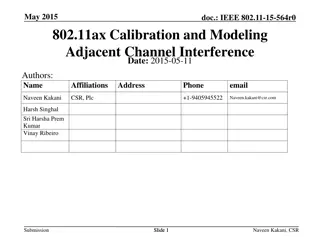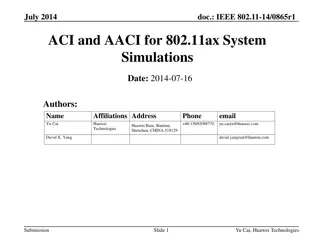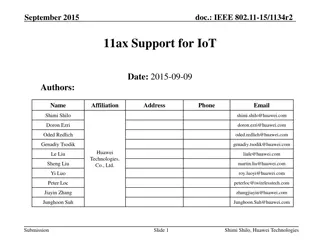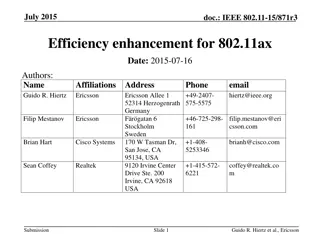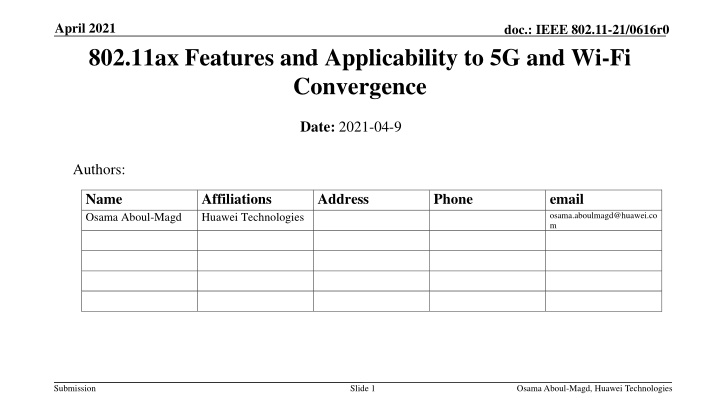
IEEE 802.11ax Features and 5G/Wi-Fi Convergence
Explore the features of IEEE 802.11ax and its relevance to 5G/Wi-Fi convergence presented by Osama Aboul-Magd from Huawei Technologies. The submission delves into topics like QoS for 5G flows, WLAN access challenges, MU-MIMO, Beam Forming, and more, providing valuable insights for industry professionals.
Download Presentation

Please find below an Image/Link to download the presentation.
The content on the website is provided AS IS for your information and personal use only. It may not be sold, licensed, or shared on other websites without obtaining consent from the author. If you encounter any issues during the download, it is possible that the publisher has removed the file from their server.
You are allowed to download the files provided on this website for personal or commercial use, subject to the condition that they are used lawfully. All files are the property of their respective owners.
The content on the website is provided AS IS for your information and personal use only. It may not be sold, licensed, or shared on other websites without obtaining consent from the author.
E N D
Presentation Transcript
April 2021 doc.: IEEE 802.11-21/0616r0 802.11ax Features and Applicability to 5G and Wi-Fi Convergence Date: 2021-04-9 Authors: Name Osama Aboul-Magd Affiliations Huawei Technologies Address Phone email osama.aboulmagd@huawei.co m Submission Slide 1 Osama Aboul-Magd, Huawei Technologies
April 2021 doc.: IEEE 802.11-21/0616r0 Revisions R0 : Initial draft to stimulate the discussion at the AANI SC Submission Slide 2 Osama Aboul-Magd, Huawei Technologies
April 2021 doc.: IEEE 802.11-21/0616r0 Background The Wireless Broadband Alliance has forwarded a liaison statement [1] to the 802.11 WG including a white paper entitiled 5G and Wi-Fi RAN Convergence . The liaison letter includes two specific requests: Need for further study within IEEE 802.11 on how fine grain QoS for 5G flows can be provided in 802.11ax and 802.11be leveraging new MAC/PHY capabilities of these standards. Challenges related to enabling QoS differentiation for 5G flows over WLAN access, especially if the QoS mapping is not addressed by WLAN vendor - one way to address this includes defining 5QIs to DSCP values to 802.11 User Priority mapping, considerations for supporting the device centric and network centric approaches for WLAN QoS differentiation for 5G flows based on IPsec child SAs, defining 5G QoS parameters to 802.11 User Priority and TSPEC parameters mapping and extending TCLAS element to support IPsec SA traffic. Submission Slide 3 Osama Aboul-Magd, Huawei Technologies
April 2021 doc.: IEEE 802.11-21/0616r0 Abstract This submission is concerned with 802.11ax features and how these may be related to WBA requirements. Submission Slide 4 Osama Aboul-Magd, Huawei Technologies
April 2021 doc.: IEEE 802.11-21/0616r0 802.11ax Features - I Item Description Remark Applicability to WBA Requirements Channel Bandwidth 20, 40, 80, 160, and 80+80 MHz Same as in 802.11ac Band of Operation 2.4 GHz. 5 GHz, and 6 GHz First 802.11 amendment to specify the operation in the 6 GHz band May be easier to find vacant wider channels (e.g., 160 MHz) available for improved performance. Waveform and Resource Units OFDMA (UL and DL) First 802.11 amendment to specify OFDMA transmission format The AP may schedule flows more often than others to achieve certain performance goal (e.g. GBR). However the scheduler is implementation dependent RUs = 26, 52, 106. 242, 484, 996, 2x996 subcarriers Submission Slide 5 Osama Aboul-Magd, Huawei Technologies
April 2021 doc.: IEEE 802.11-21/0616r0 802.11ax Features - II Description Item Remark Applicability to WBA Requirements MU MIMO UL and DL MU MIMO. MU MIMO allows for up to 8 users per RU. 802.11ac supports DL MU MIMO only. Trigger Frame (several Types) Basic Trigger Frame Triggers UL transmissions. Indicates participating STAs and RU allocation. Scheduler is implementation dependent Beam Forming Report Poll (BFRP) MU-BAR Buffer Status Report Poll (BSRP) A non-AP STA delivers buffer status reports (BSRs) to assist its AP in allocating UL MU resources Can be used as an input to the scheduler. Submission Slide 6 Osama Aboul-Magd, Huawei Technologies
April 2021 doc.: IEEE 802.11-21/0616r0 802.11ax Features - III Item Description Remark Applicability to WBA Requirements Trigger Frame (several Types) GCR MU-BAR Bandwidth Query Report Poll (BQRP) A non-AP STA may send bandwidth query reports (BQRs) to assist its AP in allocating DL MU and UL MU resources NDP Feedback Report Poll (NFRP) MU-RTS Submission Slide 7 Osama Aboul-Magd, Huawei Technologies
April 2021 doc.: IEEE 802.11-21/0616r0 802.11ax Features - VI Item Description Remark Applicability to WBA Requirements Target Wake Up Time (TWT) Individual TWT TWT is mainly a power save mechanism STAs may set individual TWT SP or follow the broadcast TWT schedule as advertised by the scheduling AP Broadcast TWT Spatial Reuse OBSS PD-based spatial reuse operation PSR-based spatial reuse operation 4x improvement in user throughput compared to 802.11n and 802.11ac Higher MCS values Simulation results show a throughput gain of about 20% [6] ?? User Experience The 4x improvement is not universal and is dependent on the traffic scenarios see [2-5] Compared to 256 QAM in 802.11ac Gain in user throughput is dependent on scenario MCS 10 and MCS 11 (1024 QAM) Submission Slide 8 Osama Aboul-Magd, Huawei Technologies
April 2021 doc.: IEEE 802.11-21/0616r0 Conclusion 802.11ax has not developed any mechanisms specific to improving the QoS No new priority access scheme or code points 802.11ax introduced a new set of mechanisms (OFDMA, MU MIMO, etc) that may improve performance measures. The improvement is related to specific implementation and traffic scenario, which do not cover the scenarios of the WBA liaison [1]. Submission Slide 9 Osama Aboul-Magd, Huawei Technologies
April 2021 doc.: IEEE 802.11-21/0616r0 References [1] https://mentor.ieee.org/802.11/dcn/21/11-21-0170-00-0000-2021-jan- liaison-from-wba-re-convergence.docx [2] https://mentor.ieee.org/802.11/dcn/17/11-17-1360-00-00ax-multiple-bss- simulations-for-par-verification-follow-up.pptx [3] https://mentor.ieee.org/802.11/dcn/17/11-17-0090-01-00ax-11ax-par- verification-using-ul-mu-mimo.pptx [4] https://mentor.ieee.org/802.11/dcn/16/11-16-1363-01-00ax-11ax-par- verification-through-ofdma.ppt [5] https://mentor.ieee.org/802.11/dcn/16/11-16-1198-03-00ax-preliminary- 11ax-par-verification.pptx [6] https://mentor.ieee.org/802.11/dcn/15/11-15-1109-01-00ax-obss-nav-and- pd-threshold-rule-for-spatial-reuse.pptx Submission Slide 10 Osama Aboul-Magd, Huawei Technologies

